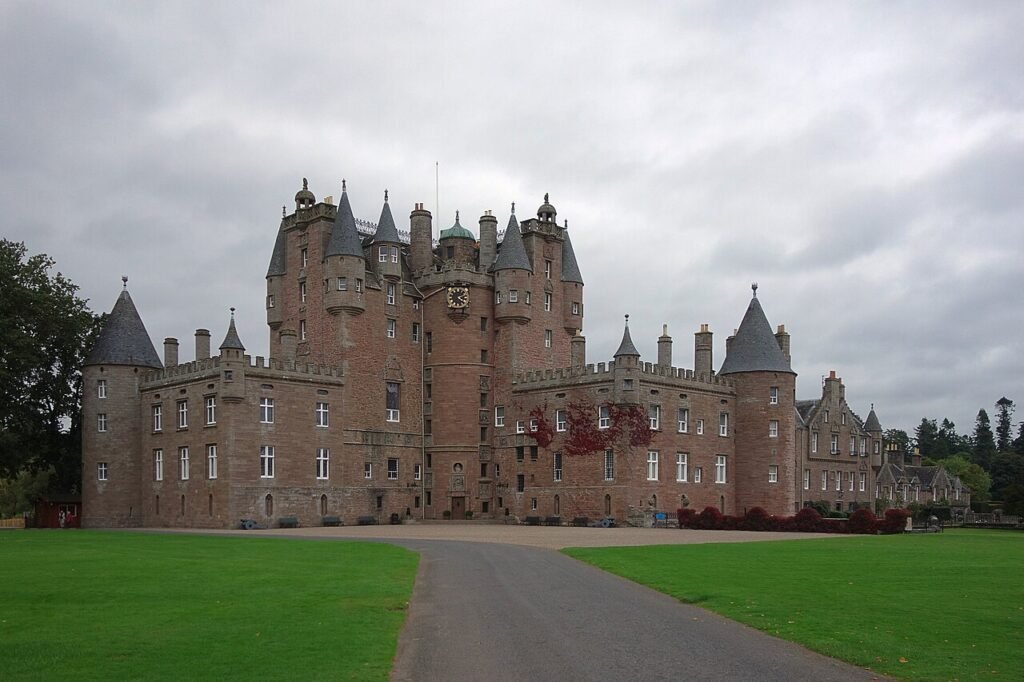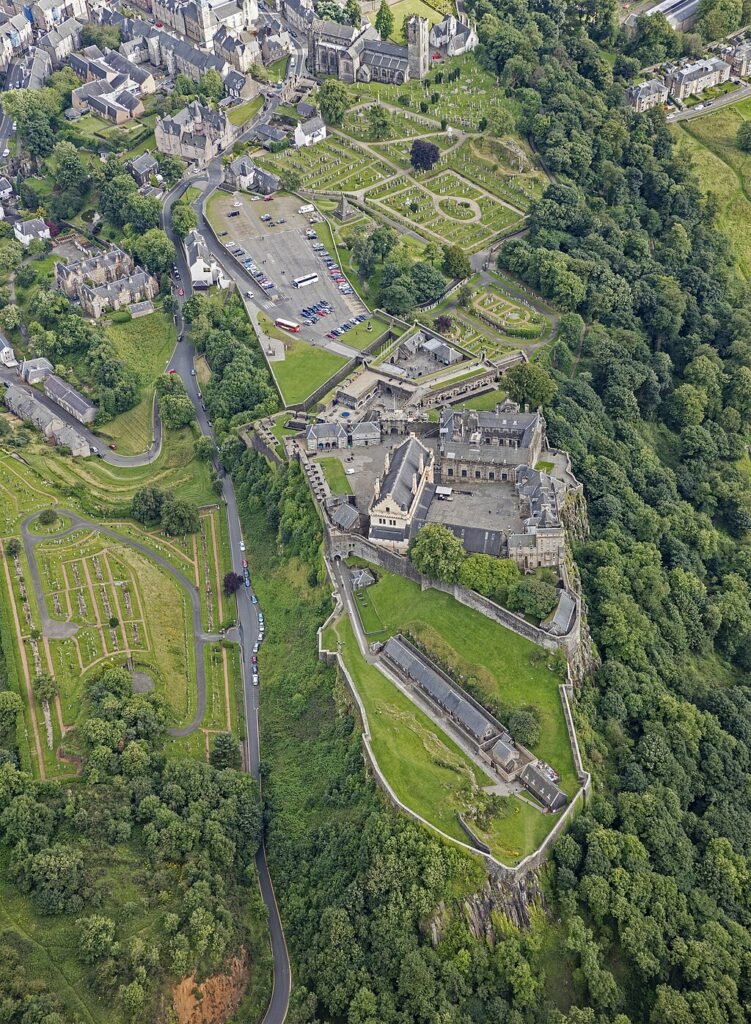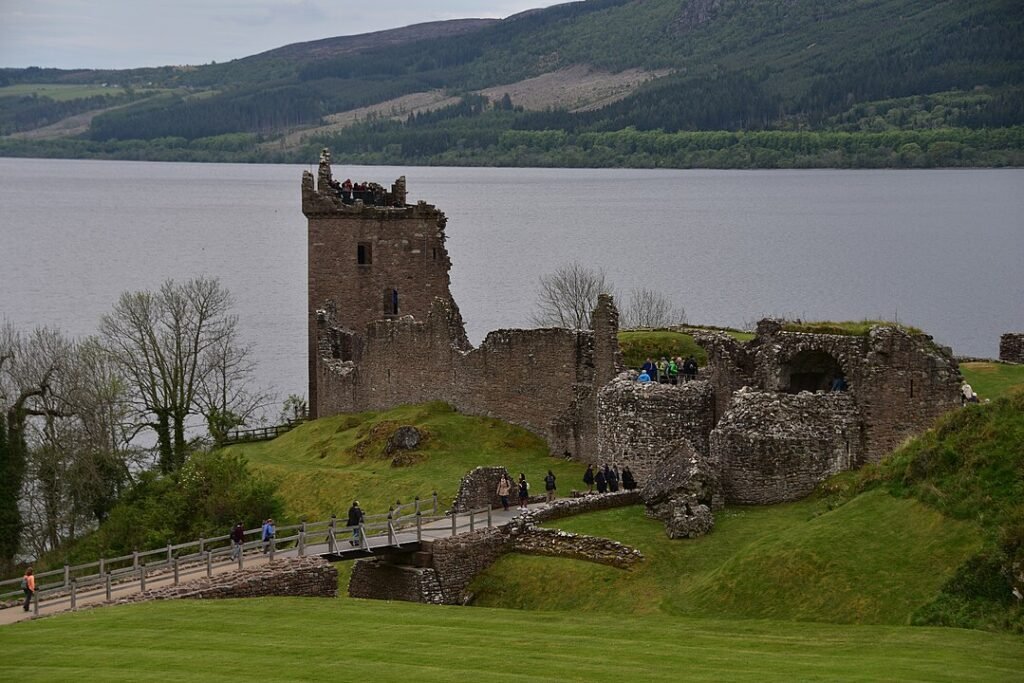
Glamis Castle is the kind of place that makes you slow the car, lower the window and just stare. Turrets, honeyed stone, a mile-long approach framed by veteran trees, then a storybook façade that somehow feels familiar even if you’ve never been. For centuries, this Angus estate has been home to the Earls of Strathmore and Kinghorne, forever entwined with Shakespeare’s Macbeth, the childhood of Queen Elizabeth The Queen Mother and the birth of Princess Margaret. It’s also one of Scotland’s most welcoming days out, with gardens for roaming, a family-friendly trail inspired by the Bard, and a calendar of events that keeps locals returning.
Whether you’re a family planning a summer escape, a couple in search of a romantic Scottish weekend, or a solo traveller tracing Scotland’s royal and literary threads, this guide will help you plan a seamless visit and use Glamis as a springboard for wider adventures across Dundee, Angus and beyond.
Why Glamis Castle belongs on your UK itinerary
Glamis Castle manages to be grand and lived-in at the same time, a rare combination. Step through the Queen Mother Gates and the scene unfolds: long views down the drive; a castle whose roots go back to the 14th century; and 1,000 acres of woodland and lawns that invite slow wandering. Add in the Italian Garden for formal colour, the Walled Garden for seasonal bounty, and the Macbeth Loop’s carved-wood sculptures for drama and play, and you’ve got a day out that mixes culture with fresh air.
The headlines at a glance
- Where: Near the village of Glamis, Angus; roughly 12 miles north of Dundee (about 30 minutes by car).
- Why it matters: Ancestral seat of the Earls of Strathmore and Kinghorne since 1372; childhood home of The Queen Mother; birthplace of Princess Margaret; long associated with Shakespeare’s Macbeth.
- What you’ll see: A guided castle tour (about 50 minutes) through state rooms and stories; formal and woodland gardens; seasonal exhibitions and family trails; solid café and tearoom options.
- Best for: Families who want space to explore, couples seeking a cinematic backdrop, solo history-hunters, and anyone folding Dundee/Perth/Angus into a Scotland trip.
A (very) short history: from medieval stronghold to modern icon
The story begins in 1372, when Robert II granted the Thanage of Glamis to Sir John Lyon. The Lyon family (later Bowes-Lyon) built and rebuilt over the centuries, shaping the L-plan tower house into the French-influenced, turreted silhouette you see today. Glamis hosted Mary, Queen of Scots; withstood political tides; and later became a place of royal childhood summers.
Shakespeare set part of Macbeth here. Macbeth is introduced as “Thane of Glamis”, and although the historical Macbeth long predates the current castle, the association stuck, seeding centuries of legend. In the 20th century, Glamis became intimately connected with Britain’s modern monarchy: Lady Elizabeth Bowes-Lyon (later The Queen Mother) spent her childhood between Glamis and family homes in England; her daughter Princess Margaret was born at the castle in 1930, the first senior royal born in Scotland for generations. Today, the estate continues to evolve, balancing conservation with visitor welcome, community life, and a lively events diary.
What to see and do: rooms, gardens, trails and exhibitions
The guided castle tour
Visits begin with a timed, guided tour, well-paced and personal, with guides who thread together architecture, royal anecdotes and local lore. Expect richly furnished rooms, portraiture that maps 650 years of family history, and the kind of detail that makes eras feel close: a chapel with a hush, stories of wartime convalescent care when the dining room held hospital beds, and rooms whose names King Malcolm’s Room and Duncan’s Hall nod to the myths that cling to the place.
Photography etiquette: Interior rules can shift with exhibitions and conservation needs; assume restricted photography inside and follow your guide’s lead. Outdoors is fair game, bring a lens for those turret lines, while drones are not permitted on the estate.
The gardens: four distinct moods
- The Italian Garden – Created in the early 20th century by Countess Cecilia (mother of The Queen Mother), this is a symmetrical and seasonal colour, with clipped hedging and statues for punctuation. It’s late-spring/early-summer heaven.
- The Walled (Kitchen) Garden – Four acres of productive borders, glasshouse fruit and heritage varieties that keep the estate kitchens busy. Expect changing palettes from spring rhubarb and tulips to high-summer abundance.
- The East Woodland & Pinetum – Towering conifers, shaded paths and wildlife; a natural counterpart to the formality of the Italian Garden.
- The Macbeth Loop – A family favourite: seven sculptures carved from estate wood, each riffing on a scene from Macbeth. It doubles as a storytelling spine for younger visitors.
Exhibitions and behind-the-scenes stories
Glamis Castle often mounts seasonal displays, think archives, servant’s stories, kitchen kit across eras, or a sustainability-themed exhibition exploring how a rural estate feeds, heats and supports itself. It’s a good way to understand how stately homes functioned (and function) beyond the showrooms.
Practical planning: tickets, timings, access and how to get there
Opening times in 2025
Glamis Castle and Gardens are open daily in the main season, with the castle tour running on a timed basis throughout the day and the last tours in late afternoon. Always check the official site before you travel for any short-notice changes, private events or altered hours.
Tickets & tours
You can buy castle-and-gardens tickets on the day; booking online in peak season is sensible to secure a comfortable tour slot. There’s also a gardens-only ticket if you’ve toured the castle before or you’re mainly here for a walk, lunch and a wander. Family tickets offer good value for two adults and up to three children.
Tip: Arrive for a morning tour, break for lunch in the Castle Kitchen, then loop back to the Italian Garden and Macbeth trail while the midday tours are busy.
Accessibility
The guided route includes staircases and some uneven floors; wheelchairs have good access to the Castle Kitchen restaurant, shop and certain exhibitions. Paths in the gardens are a mix of gravel and grass, with benches for pauses. If step-free access is vital, plan for a gardens-first visit and ask staff about any adapted routes or visual materials for interior spaces.
Photography & drones
Expect restrictions on interior photography to protect delicate surfaces and ensure tours flow; outdoor photography is welcomed. Drones and BBQs are not permitted anywhere in the gardens and grounds.
Facilities, food and parking
There’s ample on-site parking close to the visitor hub, café and shop (included with pre-booked tickets). Toilets (including accessible facilities) are signed from arrival. Food-wise, the Castle Kitchen (in the Victorian kitchens) does lunches, bakes and afternoon teas; The Old Larder serves takeaway coffee and snacks for garden wanders.
Getting there
- By car: From Dundee, the A90 then A94 puts you at the gates in around 30 minutes; from Perth or St Andrews, allow 45–60 minutes; from Edinburgh/Glasgow, 1½–2 hours depending on traffic.
- By bus: Regular Stagecoach services run Dundee ↔ Kirriemuir via Glamis; alight for the village and walk the estate approach (allow extra time with kids).
- By rail: Dundee is the nearest station (about 12 miles); buses to Glamis depart from Seagate Bus Station.
EV drivers: Charging provision on rural estates fluctuates, use national maps (Traffic Scotland/PlugShare) to plan reliable stops in Dundee/Perth/Forfar rather than banking on destination charging.
Visiting with kids, as a couple, or solo
Families
Bring wellies or sturdy trainers: lawns, woodland paths, and the Macbeth Loop eat up kid-energy. Inside, the 50-minute tour works well for school-age children thanks to engaging guides and plenty of stories (you may wish to use a sling rather than a buggy inside). The café caters to small appetites, and the shop does a good line in pocket-money souvenirs.
Top family moments: Spotting red squirrels in the East Woodland; hunting for Shakespearean clues on the sculptures; peeking at kitchen gadgetry across eras.
Couples
Arrive for opening to have the approach (and photos) to yourselves, then linger over the Italian Garden and a long lunch. Return for golden-hour shots from the lawns, sunset light on turrets is as romantic as it sounds.
Solo travellers
Glamis rewards unhurried exploration. Do the first tour of the day, then explore the gardens and woodland loops at your pace. If you’re building a deeper thematic trip, pair Glamis with Macbeth-linked landscapes in Perthshire (Birnam Oak, Dunsinane Hill) or with coastal castles like Dunnottar for a contrasting atmosphere.
Sample itineraries you can actually follow
1) Dundee + Glamis in One Day (Families or First-Timers)
Total drive: ~1 hour round-trip from Dundee
Morning (Dundee):
Start at the V&A Dundee (Scotland’s design museum) or Discovery Point to board RRS Discovery. Both are hands-on and great for kids. Grab coffee and a pastry on the quay.
Late morning (drive 30 mins):
Head to Glamis for a late-morning castle tour.
Lunch:
Castle Kitchen: keep it simple with soup, a hot main or a hearty sandwich.
Afternoon:
- Italian Garden for family photos.
- Macbeth Loop: let the kids “collect” the sculptures while you enjoy the woodland.
- Time-allowing, detour 10 minutes to the Eassie Sculptured Stone (a 7th-century Pictish cross-slab in a roofless kirk) for a quick, atmospheric stop.
Dinner (Dundee):
Return to the city for dinner around the cultural quarter.
Why it works: Minimal driving, maximum variety, and a satisfyingly complete sense of place—sea, city, castle, countryside—in one day.
2) Angus & The Coast (2 Days, Couples)
Base: Dundee or Kirriemuir
Day 1 – Glamis & Angus countryside
- Morning: Early arrival at Glamis for a quiet tour and garden time.
- Lunch: Afternoon tea at the Castle Kitchen if you’re in a celebratory mood.
- Afternoon: Drive 25–35 minutes to House of Dun (Montrose) for Georgian elegance and riverside walks, or aim for Montrose Basin for birdlife.
- Evening: Dinner in Kirriemuir (cosy pub) or Dundee (waterfront restaurants).
Day 2 – Red-Sandstone Coast
- Morning: Arbroath Abbey (birthplace of the 1320 Declaration) and harbour smokies.
- Afternoon: Dunnottar Castle (Stonehaven), a cliff-top ruin that’s catnip for photographers.
- Return: Scenic A92 coastal drive back to base.
Why it works: A blend of heritage, coast and classic Scottish drama, with Glamis as your anchor.
3) Macbeth Country & Royal Perthshire (2–3 Days, Solo or Themed Trip)
Base: Perth or Dunkeld
Day 1 – Glamis & Kirriemuir
- Morning: Tour Glamis; add the Sustaining Glamis exhibition if running.
- Afternoon: Explore Kirriemuir (J.M. Barrie’s birthplace, gateway to the Angus Glens). Short walks in Glen Clova if the weather behaves.
- Evening: Overnight near Glen Clova for dark skies and a sense of remoteness.
Day 2 – Macbeth Trail
- Morning: Drive ~1 hour to Dunkeld/Birnam to see the Birnam Oak, a survivor of the forest immortalised in Macbeth.
- Afternoon: Hike Dunsinane Hill (short, steep; fine views over the Sidlaw Hills).
- Evening: Stay in Perth/Dunkeld; check for any Macbeth-themed exhibitions or talks.
Optional Day 3 – Palaces & Gardens
- Morning: Scone Palace (site of Scottish coronations).
- Afternoon: Drummond Castle Gardens near Crieff for a formal parterre on a grand scale.
- Evening: Return via country roads and farm-shop stops.
Why it works: Literature, landscape and royal ritual weave into a coherent story, with manageable drives and real variety.
Seasonal highlights & special experiences
- Spring (March–May): Daffodils along the approach, blossom in the Walled Garden, first warmth in the Italian Garden. Shoulder season crowds and lively birdlife in the East Woodland.
- Summer (June–August): Long days, family trails and outdoor events. Expect weekend festivals—vintage motors, outdoor concerts, summer fun days—and busy tour slots: book earlier hours for breathing space.
- Autumn (September–October): Copper light on the stone, fiery woodland colours, quieter paths and a last burst of garden interest. Late October often brings atmospheric evening tours for Halloween fans.
- Winter (selected dates): While the main castle season winds down, look out for gardens-only dates, festive markets or light trails some years. Always check the official calendar before you plan.
Photography moments: Morning mist on the drive; Italian Garden symmetry in late afternoon; golden hour on the west elevation; after-rain reflections along the lawns.
Where to eat near Glamis (and what to expect)
- Castle Kitchen (on-site): Reliable soups, seasonal mains, local baking and classic afternoon tea in the former Victorian kitchens.
- The Old Larder (on-site): Takeaway coffee and snacks – ideal for walkers.
- Kirriemuir (10 minutes): A handy stop for pub lunches and cafés; it’s a small town with a proud literary and musical pedigree (Barrie and Bon Scott).
- Dundee (30 minutes): Waterfront restaurants with views and a wider choice, from seafood to modern Scottish menus.
Foodie tip: Pair Glamis with a coastal detour to Arbroath for smokies (the protected-status, hot-smoked haddock that’s an Angus classic).
Where to stay: from countryside lodges to city spa comfort
- Glen Clova Hotel & Lodges (Angus Glens): A mountain-foot retreat with rooms, lodges and hot-tub houses – perfect if you want big skies and trailheads on your doorstep.
- Dundee – Apex City Quay Hotel & Spa: Contemporary rooms, a spa and parking by the waterfront; ideal if you’re mixing museums with your castle day.
- Airlie Arms (Kirriemuir): Friendly, good-value hotel with a straightforward restaurant, handy for early starts to Glamis and the glens.
How to choose:
- Families might prefer a self-catering lodge base in the glens or a Dundee hotel with a pool.
- Couples often split the stay: one rural night (for stars) plus one city night (for dinner).
- Solo travellers tend to favour walkable town bases (Dunkeld, Perth, Dundee) with easy public transport and evening options.
Beyond Glamis: castles and gardens to build a bigger trip
- Cawdor Castle (near Nairn): A living family home with fairytale gardens; often (gently) linked to Macbeth in the public imagination.
- Dunnottar Castle (Stonehaven): A clifftop ruin with waves booming below, dramatic, photogenic, unforgettable.
- Scone Palace (Perth): Coronation site of Scottish kings; peacocks, lawns and history layered deep.
- Drummond Castle Gardens (Crieff): One of Europe’s finest parterres, if Glamis’ Italian Garden whets your appetite, this is the next step up.
- Edinburgh & Stirling Castles: For full-on fortress drama and big-picture Scottish history.
This cluster makes it easy to craft a “castles and gardens” week that never feels repetitive: each place has a distinct character, landscape and story.
Responsible and stress-free visiting: smart tips
- Book earlier slots in peak months to avoid bunching; linger in the gardens while later tours cycle through.
- Layer up: Scottish weather changes by the hour; even in August, a light waterproof earns its place.
- Footwear: Paths are mixed surface; trainers or boots beat slippery soles.
- Wildlife sense: Woodland means ticks, cover ankles in long grass and carry repellent in summer.
- Leave no trace: Stick to paths in the formal gardens; keep dogs on leads; respect drone and BBQ rules.
- Public transport backup: If you’re bus-ing from Dundee, screenshot timetables and allow generous transfer time at Seagate Bus Station.
Frequently asked questions
How long should I allow?
Three to five hours covers a tour, lunch and gardens without rushing. Add time if you’re doing the Macbeth Loop with kids or a photography session.
Is Glamis good in the rain?
Yes – tours run whatever the weather, and the café/shop make warm bolt-holes. Gardens transform beautifully after rain, with reflections and saturated colour.
Can I see the gardens without visiting the castle?
Yes – there’s a gardens-only ticket. Handy for dog-walkers or repeat visitors.
Is it stroller-friendly?
Prams don’t fit well in the historic interiors; consider a sling for babies. The grounds, paths and facilities work well for families.
Wider UK tie-ins: themes to weave into your travels
Heritage travel with a royal thread
From Glamis’ Queen Mother connection to Windsor and Holyroodhouse, royal homes shape the UK story. In Scotland, a Deeside detour to Balmoral’s estate grounds (seasonal) extends the narrative.
Literary landscapes
Pair Glamis’ Macbeth lore with Perthshire’s Birnam Oak and Dunsinane Hill, then slide south for Wordsworth country in the Lake District or Hardy’s Dorset if your trip crosses borders.
Castles & coast
Contrast inland splendour with Dunnottar’s sea-spray drama, Bamburgh in Northumberland, or Tintagel in Cornwall (if you’re ranging far). Each adds a different kind of wildness to the architecture.
Design & industry
Glamis pairs naturally with V&A Dundee and the city’s shipbuilding heritage at Discovery Point, a reminder that Scottish creativity spans couture to clipper ships.
The perfect day at Glamis: a simple plan to steal
Arrive for opening and absorb the first ripple of “wow” down the avenue. Take the morning tour while your energy and curiosity are high. Break for lunch in the Castle Kitchen – slow down, people-watch, choose cake. Spend the afternoon outside: Italian Garden first, then the Walled Garden and Pinetum, finishing with the Macbeth Loop so younger travellers can lead the way. If the light is golden and you’ve still got miles in you, detour to Eassie Old Church for a five-minute immersion in the Pictish past. You’ll drive away with a head full of stories and at least one “we’ll be back”.
Need-to-know (quick recap)
- Season: Open daily across the main season; confirm dates/hours before travel.
- Tickets: Castle & Gardens or Gardens-only; family ticket available; online booking recommended in summer.
- Access: Interior tours include stairs; step-free access to café, shop and selected exhibits; mixed-surface paths outdoors.
- Getting there: Car via A90/A94; buses Dundee–Kirriemuir via Glamis; nearest rail Dundee.
- On-site: Ample parking, café and takeaway, gift shop, loos, dog-friendly gardens (on leads).
- Rules to note: Follow interior photography guidance on the day; no drones; BBQs not permitted.
Final thought
Glamis is a masterclass in why UK heritage travel endures: a living home with deep roots, tuned to modern visitors without sanding off its edges. Go for the history; stay for the gardens; leave with a bigger map in mind of castles, coasts and creative cities that make a Scottish (and UK-wide) itinerary far richer than a checklist of headlines.


